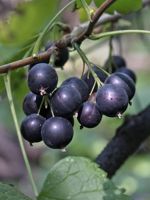Mon-Fri 9am - 5pm Mountain time
Alpine Currant vs Northern Black Currant
Ribes alpinum
Ribes hudsonianum
NOT AVAILABLE THIS SEASON - MIGHT RETURN
CUSTOM GROW
Alpine Currant is a great shrub to plant along sidewalks, near building or at your property boundary as a hedge or accent species. It is widely used by commercial landscapers in parking lots and near buildings because of its hardiness, attractiveness, and pollution tolerance.
While Alpine Currant produces edible berries, they are not palatable.
Northern Black Currant is a native deciduous shrub found across Canada and the northern United States. Dark purple to black berries that ripen in summer and provide food for wildlife and humans. Fragrant yellow-green flowers that attract a wide variety of pollinators.
This shrub is well adapted to moist soils and can even survive periods of flooding. It has an interesting bronze colour in fall.

